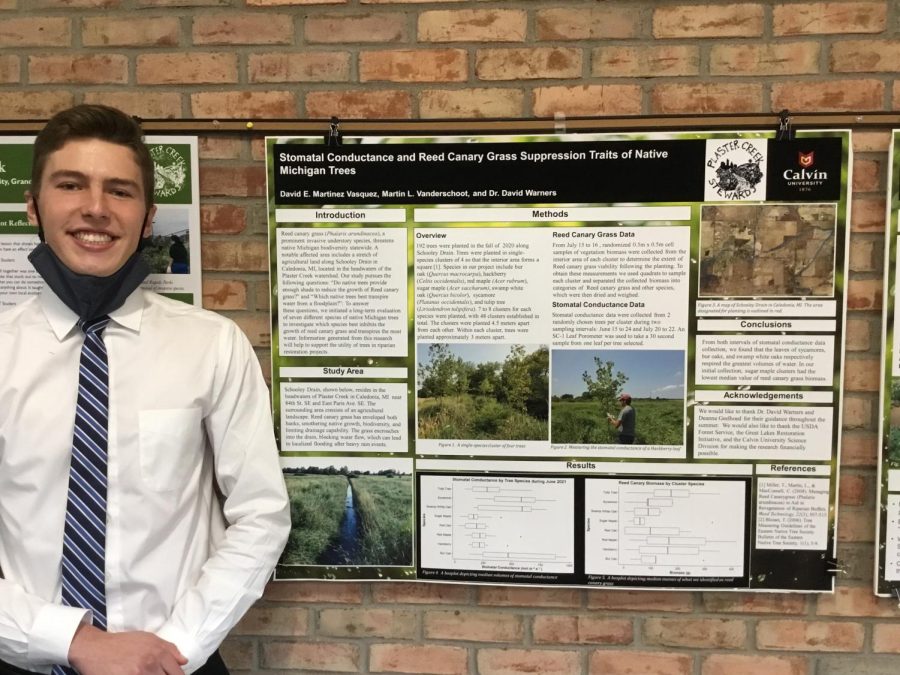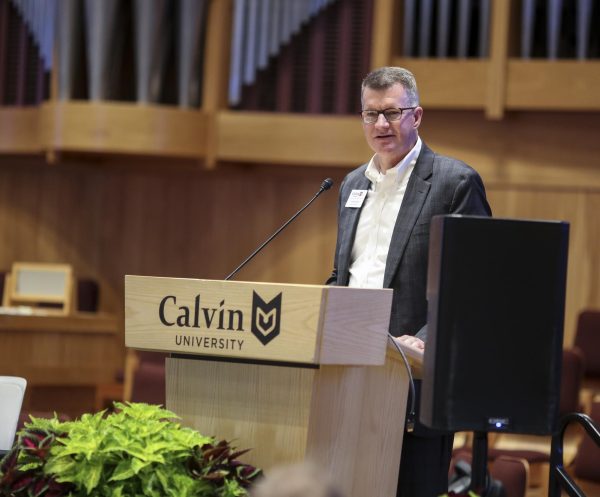Changes in course release costs aim to increase research opportunities
Changes in course release costs will lead to more research opportunities for faculty and students.
Calvin Research Fellowships and sabbaticals – programs that provide faculty with paid time to pursue research – have become more accessible thanks to an anonymous donor and budgeting changes. Money available for faculty conference travel has increased as well, from a base rate of $1,000 to $1,500.
Calvin has long been an institution that values both research and teaching, according to biology professor David Warners, but because of budget cuts in the last two years, professors were doing more teaching with less time for research. The increased availability of CRFs and sabbaticals are a step towards returning to the university’s dual focus.
Sabbaticals and CRFs allow faculty to reduce their teaching load in order to focus on research without taking a pay cut. A sabbatical relieves a professor of all teaching responsibilities for a semester while a CRF reduces the number of classes they are required to teach.
“They effectively buy out a faculty member’s time to work on research during the academic year,” said David Dornbos, chair of the biology department.
Tenure-track faculty are eligible for sabbatical every seven years, but they can apply for a CRF every year. Priority consideration is given to applicants who have not received CRF for the past three years consecutively.
“Those constraints [on CRFs] are typically only taken into consideration when we have budget constraints,” said David Wunder, dean for faculty development and research initiatives.
Budgeting
Recently, budgets for CRFs and sabbaticals have been limited. According to Wunder, there were substantial budget cuts in the two years prior to this academic year.
However, the budget cuts did not continue into this year.
“This fall, we were able to fund sabbaticals and CRFs at levels that are the highest in the last 15 years,” said Wunder.
Increases in the budget for sabbaticals and CRFs, due in part to changes in the number of full-time faculty, have played a role in this shift, driven mostly by administrative decision-making, according to Wunder.
“We were budgeting at that more conservative level and now it’s sort of budgeted like ‘We can do this,’” said Brian Bolt, dean of education.
Changes to how release time is charged will also allow faculty to maximize their CRFs. Previously, CRFs were based on the faculty member’s employment package, rather than the cost to employ an adjunct. Going forward, release time will be charged based on the cost to hire an adjunct to teach the number of credits the faculty member is released from.
“We’re now budgeting for replacement cost, as opposed to a person’s actual salary,” said Bolt.
Because adjuncts are not paid benefits, the amount faculty are now expected to cover is generally much lower than under the old system.
The older system of charging release time may have reflected an older system of hiring replacements.
“We used to be able to hire someone full-time for that time if someone was going on sabbatical,” said Jolene Vos-Camy, chair of the world languages department.
Now, the university uses adjuncts to cover sabbaticals. While this change has been common in academia for the past several years, it poses obstacles for faculty considering a sabbatical.
“I know that some of my colleagues in the world languages have been hesitant to apply for sabbaticals in the past, because it was so challenging [for the department] to replace their courses,” said Vos-Camy.
Official communications have affirmed that this budgeting change applies to internal funding such as grants and CRFs, but professors are hopeful that it will also apply to external grants.
“If it does apply to grant buyout time, that really would be contributing to scholarship at Calvin,” said Dornbos.
Importance of research
Historically, Calvin’s scholarship output has been far higher than that of many small colleges, according to Bolt. This is in part because research is included as one of the three areas in which Calvin professors are required to show engagement to qualify for tenure.
“Here at Calvin, we have to show that we’ve been engaged in research, we have to show that we take our teaching seriously and that we’re involved in service,” said Dornbos, so “scholarship is part of our job description.”
Many professors, including Dornbos himself, came to Calvin because they wanted to do both teaching and research, Dornbos told Chimes.
However, with budget tightenings and increasing teaching workloads, dedicating the appropriate time to each of these areas has been challenging, according to Warners. “If your teaching load is heavier, your teaching isn’t as good … and you can’t get your research going,” he said. “Because there’s been more responsibility associated with the teaching, these other two areas have suffered.”
When faculty are engaged in research, they are “highly encouraged to have undergraduate students do research with us,” Warners said. Through research involvement, students can better make career choices and get references.
Younger faculty have a harder time getting external grants to fund research, because they don’t have much of a track record. “So, the internal funding, like the CRFs and the sabbaticals are so helpful,” Warners said.
Internal funding also gives less experienced faculty time to conduct research during the school year. “[They] don’t have two, three years of experience teaching a certain course that would free them up,” Warners said, so CRFs are invaluable. “Any way that Calvin can support that research I think is absolutely wonderful,” he said.
Warners and Dornbos said they would love to see the increase in funding applied to summers, when most scholarship happens, as well.
Reimbursement for summer research –– both for faculty and student research assistants –– is much lower than at other institutions, such as University of Michigan and Pierce Cedar Creek Institute, according to Dornbos.
“If we really, at Calvin, wanted to support scholarship, we’ve got to look at summer months, too,” said Dornbos.
Travel funding
Travel funding for faculty has also increased for the 2023-2024 school year, from a base rate of $1,000 to a base rate of $1,500. If faculty present a paper or are somehow contributing to a conference, they receive an additional $500. If they present research co-authored with a student, their budget increases to $2,500, according to an email announcing the change sent by Provost Noah Toly.
“The more you present papers the better,” Bolt said. These added incentives for presenting, especially with students, “help students … and also the prestige of the university,” according to Bolt.
The pre-COVID travel budget was appropriate pre-COVID, according to Dornbos, but now, with increases in costs of travel, “A thousand bucks doesn’t go very far, and so people stopped going,” said Bolt, particularly to bigger or non-local conferences.
The increase is “about right,” according to Dornbos.
The professors Chimes spoke with said they think the move towards higher levels of faculty research support is a step in the right direction overall.
Mark Mulder, sociology professor, said that the reinvestment in scholarship is a good sign, because an emphasis on scholarship has “long set us apart as a Christian college.” Vos-Camy is “very pleased that funding has been found to support faculty research in that way,” she said.
According to Wunder, the increased support for faculty research is intended to be long-term. “We’re committed to continuing this kind of investment into the future,” said Wunder.









